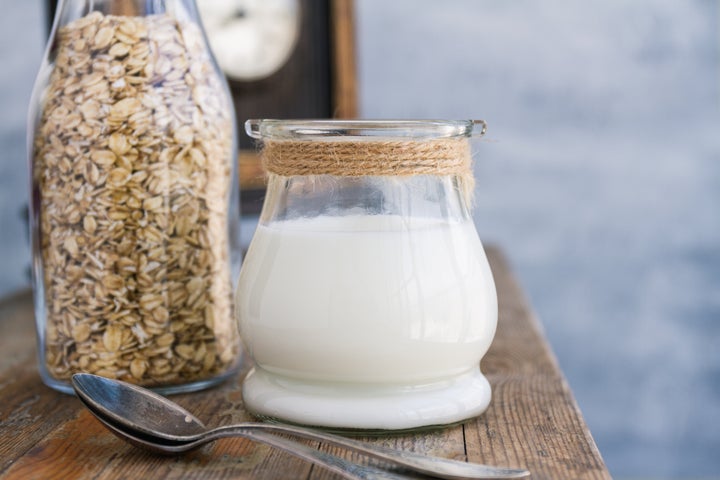
HuffPost UK may collect a share of sales or other compensation from the links on this page if you decide to shop from them. Oh, and FYI – prices are accurate and items in stock as of time of publication.
After watching YouTube coffee expert James Hoffmann explain how to froth milk about 10 times, I attempted it by myself confidently, only to realize how finicky a frother is. And the milk that goes in it.
Sesame milk turns into a hot puddle, while skimmed holds what I’ll loosely call microfoam. If you’ve ever tried steaming milk at home, you’ll know that not all milk and dairy-alternative milk (sometimes called mylk) are created equal.
HuffPost interviewed three baristas to find out the best and worst milk and milk alternatives for lattes.
Choose your own latte adventure
“In terms of being able to steam (or froth) any milk alternatives at home, all milk can be frothed to some degree. It depends on the end use,” Jill Hoff, director of coffee and education for Monogram Coffee, tells HuffPost.
“I personally find that any mylk that has been formulated as a ‘barista blend’ will usually have a better overall texture and taste with coffee, so I would tend to stick with products specifically designed this way.”
Two crucial elements for steaming and foaming are protein and fat. Protein helps build the foam and fat distributes the flavour. While there isn’t an ideal protein number to look for, having enough is key to bubbly success or failure.
But many alt-milks are lacking in the protein department, which has led to a souped-up version with the descriptor “barista blend.” This version makes it easier for your favorite fake milk to froth and foam.
“Milk alternative brands usually create barista versions with enough protein-stabilisers added to ensure foam stability, so we can pour beautiful latte art. Fat content mainly contributes to the taste of the milk,” says Kaleena Teoh, the director of education for the Coffee Project NY.
Experts rank the best dairy milks for lattes
Whole milk (best dairy choice)
If you choose dairy for your home latte, go with whole milk. “In milk frothing, whole milk will be the easiest dairy to froth,” Teoh said. “All other milk-milk alternatives will need a little more practice to balance the aeration and incorporation of air into the milk.”
The “Goldilocks” of the dairy choices, whole milk has neither too much nor too little fat, which allows for great flavour and texture and is the go-to of many cafes. “Most people enjoy the flavour of whole milk due to its full-fat content that provides more sweetness and a richer profile that compliments espresso,” Teoh explains.
Skimmed milk
Although skim milk has had most of its fat removed, it can still be effectively foamed. According to Teoh, this milk “usually produces a lot of foam when frothing. A skim latte is a good choice.” But if you’re used to that creamy and rich flavour traditionally associated with a latte, skim might not cut it. Teoh describes the skim milk latte as tasting more watered-down and less satisfying than whole milk or cream.
Half-and-half (worst dairy choice)
Remember the Goldilocks metaphor? In this case, with half-and-half’s rich 12% fat content, drinking a whole latte could be uncomfortable for most people. “Cream has the highest fat content and is not used in a latte because the result is often too rich, and a lot of people find it too heavy to finish a cup,” Teoh said. If sipping on the equivalent of steamy ice cream is your thing, cream works well for frothing and foaming, and has the additional benefit of being able to foam while cold.

Oat milk (best nondairy milk)
Luscious and naturally sweet, oat milk has gained a cult following for its perfect pairing with coffee drinks like the latte.
“There’s a wide range of excellent oat milk brands that steam well, although some perform better than others,” Tohm Ifergan, founder and CEO of Dayglow Coffee, says.
Both barista blend and regular oat milk tend to froth, foam and steam well, thanks to the water-soluble fiber in the plant. As for brands, “Oatly may have the creamy mouthfeel people seek in milk, but brands like Minor Figures or Ghost Town Oats have a smoother consistency when texturing milk that allows for great latte art,” Ifergan says.
Almond milk
This lower-fat nut milk can be a trickier one to steam. Ifergan recommends choosing a barista blend if almond milk is your preferred alt. He explains that this drink can be hard to steam due to its fat content. “Also, with coffee being so acidic, it’ll cause whatever fats in the milk to separate, which is a critical issue.”
“Califia, to me, is the only brand that does an excellent job in creating balanced almond milk that texturises like regular milk,” Ifergan says. “It may not have the same fresh almond milk flavour you may enjoy making at home. However, it’s the only almond I’d ever recommend to be paired with espresso for the reasons above.”
Cashew milk
“I personally prefer nut-based milk for alternatives,” says JP Plourde, co-owner of Cafe Myriade. “The advantage of cashew milk, just like the majority of nut-based milk, is that they have higher fat content and require fewer additives to remain stable when and after steaming. Fat content also helps a lot to achieve a nicer texture and enhance coffee flavour.”
Try steaming at a lower temperature to avoid altering the flavour with a range of nut-based milks on the market, from macadamia to hazelnut to pistachio (Plourde’s personal fave).
Pea-based milk
With a similar protein and fat composition as whole dairy, pea-based milk can be a great option without sacrificing macros.
“To nicely steam pea milk, you have to aerate for a shorter period, always depending on your wand pressure,” Plourde says. “Once steamed, I would avoid letting your pitcher sit as the foam texture is generally less stable ― which is also a good rule of thumb when steaming.”
Coconut milk
“Coconut milk is high in sugar and fat, and low in protein, making it a bit trickier to master steaming for good microfoam, which you need to pour good latte art,” Hoff says. “However, the fat, sugar and flavour profile interact with coffee and make for a tasty dairy-free option!”
If you choose coconut milk for your latte, look for the carton rather than the canned option. Coconut milk in a carton is thinned with water and designed to be used in your favourite bevies.
Soy milk (worst of the nondairy category)
This plant-based OG isn’t your best bet when it comes to frothing. ”One thing that we often find true is that soy milk curdles a little easier than other dairy and nondairy when poured into coffee,” Teoh says.
The safest bet may be to save this alt-milk to your favourite cold brew or iced coffee. Try using a hand frother, which doesn’t add hot liquid or cold foam soy milk. “Soy milk interacts well with coffee, but it is more of an acquired taste when paired with coffee because it is quite earthy tasting!” Hoff says.
There aren’t necessarily good or bad choices when it comes to making your coffee at home. Taste is highly personal, so it really comes down to adapting how you steam the beverage that fits your diet, and working with how the beverage responds to steaming.